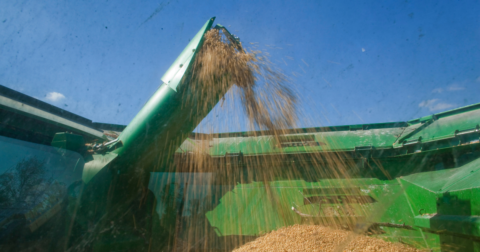News
The Trump Administration Wants to Gut The Clean Water Act
Policy•8 min read
News
President Trump’s trade war has hit America’s biggest agricultural export.


Words by Seth Millstein
In response to the increasingly steep tariffs imposed by President Trump, China has stopped buying U.S. soybeans, 97 percent of which go to feed livestock. That’s a big deal, as soybeans are the largest U.S. agricultural export by far, and China is the biggest buyer of them for their expanding factory farm industry. China’s boycott has U.S. soybean farmers panicking, praying for a bailout and wondering what they’re going to do with the piles of soybeans that no longer have a buyer.
The predicament soybean producers find themselves in is the result of Trump’s trade war with China, which began in February when the president imposed a 10 percent tariff on Chinese imports. This kicked off a back-and-forth between the two countries, with each levying progressively more severe tariffs on one another.
In May, months after imposing a 10 percent tariff on soybeans, China stopped purchasing U.S. soybeans altogether, and it hasn’t bought any from the U.S. since.
This is a big deal because Chinese exports make up an enormous share of the U.S. soybean market. The U.S. exports around 50 percent of all soybeans it produces, and over half of those exports go to China — “primarily to feed its factory-farmed pigs, chickens, and fish,” writes Marina Bolotnikova in Vox.
In other words, as a result of China’s boycott, around a quarter of all soybeans produced in the U.S. no longer have a buyer. Needless to say, this leaves a large hole in the pockets of U.S. soybean farmers — a $12.6 billion dollar hole, to be exact, if 2024 numbers are any indicator.
Of course, this also has a reciprocal effect on China, as it no longer has the 25 million metric tons of soybeans that it would otherwise have purchased from the United States. To make up for this shortfall, China has increased its soybean imports from other countries, specifically Brazil. Soy farms in Brazil drive deforestation, especially in the Cerrado, a savannah known for its biodiversity and ability to store carbon deep underground.
China’s soybean boycott hurts all U.S. soybean farmers, whether you sell within the U.S. only, or rely heavily on exports. The rules of supply and demand mean that a sudden excess in a product’s supply causes its price to fall, and falling prices are felt by all producers and sellers of soybeans.
“Even if you find yourself to be a farmer who sells to a biodiesel plant, you’re still going to suffer from the depressed prices from the extra soybeans lingering on the domestic market,” Andrew Muhammad, professor of agricultural and resource economics at the University of Tennessee, tells Sentient. “Everybody’s negatively affected.”
As a result of all of this, many soybean farmers now have a massive excess of beans with no clear way to offload them. What happens next?
Some farmers might try to export them to other countries. But that’s easier said than done. “There aren’t really alternative markets large enough to absorb these extra soybeans that we have available because of the Chinese not buying,” Muhammad says. “It’s not like you don’t see any increases, but you just don’t see enough to fully make up for lost export sales of China.”
Soybean producers may seek out alternative domestic markets for their products, Rabail Chandio, assistant professor in economics and extension economist at Iowa State University, tells Sentient. In the future, they might pursue the market for biodiesel fuel, which can be made from soybean oil.
Though the demand isn’t there just yet, that could change, market experts say. But while that would benefit farmers financially, more biofuels would likely not benefit the planet, analysis from the World Resources Institute suggests. Crop-based biofuels emit more greenhouse gases than fossil fuels.
With international markets unable to pick up the slack, many soybean farmers are instead betting on a bailout from the U.S. government to make up for their lack of sales.
In early October, Treasury Secretary Scott Bessant suggested that the administration would be announcing “substantial support for the farmers” later in the week. Reuters reported the same day that this would take the form of a $10-$15 billion bailout aimed at offsetting the various financial difficulties farmers have faced as a result of the president’s trade war.
That didn’t happen, however; according to Politico, the bailout was postponed due to the government shutdown, though it’s worth noting the administration never explicitly confirmed the bailout in the first place and hasn’t confirmed that the shutdown played a role in delaying it.
Regardless, Trump himself has hinted at a bailout as well, and given that his first administration gave farmers a bailout after launching a similar trade war in 2018, it’s not unreasonable to assume that another one is in the cards.
At least in theory, a bailout would temporarily put money in the pockets of soybean producers who are hurting as a result of China’s boycott. This would ease some of the financial pain they’re feeling, but it could lead to even bigger problems down the line.
“Bailouts always backfire,” Muhammad says, “in the sense that they create perverse incentives.”
The predicament soybean farmers find themselves in is a perfect illustration of the unintended consequences tariffs can have on domestic agricultural producers. Trump surely wasn’t intending to hurt U.S. soybean farmers when he imposed tariffs on China, but that’s exactly what’s happening.
As China increasingly turns to Brazil to meet its soybean demand, deforestation is also likely to accelerate. Brazil is already the world’s largest soybean exporter, and both legal and illegal land clearing for soy cultivation — largely to grow feed for factory farms — has driven significant biodiversity loss and carbon emissions.
Soy alone covers 11.7 million hectares (28.9 million acres) in Brazil, half of which lie within the sensitive Amazon biome. This pressure is compounded by ongoing deforestation for cattle ranching, a leading cause of forest destruction and a major source of greenhouse gas emissions. What might ease this pressure? Climate scientists, including researchers at Project Drawdown, recommend reducing meat consumption in the U.S. and other Global North countries, where demand continues to be a significant driver.